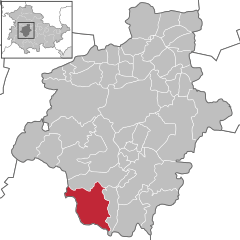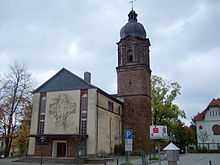Tambach-Dietharz
From Wikipedia, the free encyclopedia
| Tambach-Dietharz | ||
|---|---|---|
 | ||
| ||
 Tambach-Dietharz | ||
Location of Tambach-Dietharz within Gotha district 
 | ||
| Coordinates: 50°47′23″N 10°37′0″E / 50.78972°N 10.61667°ECoordinates: 50°47′23″N 10°37′0″E / 50.78972°N 10.61667°E | ||
| Country | Germany | |
| State | Thuringia | |
| District | Gotha | |
| Government | ||
| • Mayor | Harald Wrona | |
| Area | ||
| • Total | 41.54 km2 (16.04 sq mi) | |
| Elevation | 450 m (1,480 ft) | |
| Population (2012-12-31)[1] | ||
| • Total | 4,134 | |
| • Density | 100/km2 (260/sq mi) | |
| Time zone | CET/CEST (UTC+1/+2) | |
| Postal codes | 99897 | |
| Dialling codes | 036252 | |
| Vehicle registration | GTH | |
| Website | www.tambach-dietharz.de | |
Tambach-Dietharz is a town in the district of Gotha, in Thuringia, Germany. It is situated in the Thuringian Forest, 19 km south of Gotha.
Places of interest
- The Falkenstein is a 96 m high, free standing porphyry rock. It is a natural monument and hiking destination. The mountain rescue hut at its foot is managed.
- The route from Schmalkalden to Tambach-Dietharz is signposted as Martin-Luther-Weg and is a walking route.
- In the autumn of 1989, a monument to the Swiss Theologian, and protagonist of the Bekennenden Kirche, Karl Barth was raised in front of the Haus Tannenberg. Barth gave his "Tambacher Rede" speech, that introduced a new positioning of protestant Christianity in the 20th century, in this house in 1919.

Lutherkirche

Old post office

View along street Hauptstrasse to Lutherkirche
References
- ↑ "Bevölkerung der Gemeinden, erfüllenden Gemeinden und Verwaltungsgemeinschaften nach Geschlecht in Thüringen". Thüringer Landesamt für Statistik (in German). 13 July 2013.
This article is issued from Wikipedia. The text is available under the Creative Commons Attribution/Share Alike; additional terms may apply for the media files.
